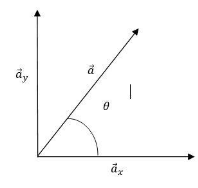
One of the Rectangular components of a vector of magnitude 50 units is 25 units. The angle it makes with this component is
(A)
(B)
(C)
(D)
Answer
493.2k+ views
Hint:Vector is defined as the physical quantity which has magnitude as well as direction.So in this question we are going to resolve a vector into two components and some mathematical calculations we can arrive at the correct result.
Complete step by step answer:
Characteristics of vectors are as follows:
1) Vectors possess magnitude as well as direction.
2) They do not obey the ordinary laws of algebra.
3) Vector changes if either magnitude or direction changes.
Any vector,

Now, according to the question.
And
From the figure above, we observe that,
By substituting the given values, we get
Therefore, the correct answer is (B)
Note:The concept of vector is very important. In some cases, direction matters as much as the length or distance. For example, say, you are driving a car with some acceleration. Then you apply a break and the car stops. Now, the car will not go from some velocity to zero velocity in an instant. The velocity will reduce gradually and become zero. That means, there is some acceleration which is opposite to the acceleration you were applying to drive the car. Now if we do not consider the fact that both the accelerations were in opposite directions, then we will never be able to explain why the car stopped.
Some examples of vector are, displacement, velocity, acceleration, force, Weight and moment.By Parallelogram law of vectors, the magnitude of resultant vector is given by,
And the direction is given by
Complete step by step answer:
Characteristics of vectors are as follows:
1) Vectors possess magnitude as well as direction.
2) They do not obey the ordinary laws of algebra.
3) Vector changes if either magnitude or direction changes.
Any vector,

Now, according to the question.
And
From the figure above, we observe that,
By substituting the given values, we get
Therefore, the correct answer is (B)
Note:The concept of vector is very important. In some cases, direction matters as much as the length or distance. For example, say, you are driving a car with some acceleration. Then you apply a break and the car stops. Now, the car will not go from some velocity to zero velocity in an instant. The velocity will reduce gradually and become zero. That means, there is some acceleration which is opposite to the acceleration you were applying to drive the car. Now if we do not consider the fact that both the accelerations were in opposite directions, then we will never be able to explain why the car stopped.
Some examples of vector are, displacement, velocity, acceleration, force, Weight and moment.By Parallelogram law of vectors, the magnitude of resultant vector is given by,
And the direction is given by
Latest Vedantu courses for you
Grade 11 Science PCM | CBSE | SCHOOL | English
CBSE (2025-26)
School Full course for CBSE students
₹41,848 per year
Recently Updated Pages
Express the following as a fraction and simplify a class 7 maths CBSE

The length and width of a rectangle are in ratio of class 7 maths CBSE

The ratio of the income to the expenditure of a family class 7 maths CBSE

How do you write 025 million in scientific notatio class 7 maths CBSE

How do you convert 295 meters per second to kilometers class 7 maths CBSE

Write the following in Roman numerals 25819 class 7 maths CBSE

Trending doubts
State and prove Bernoullis theorem class 11 physics CBSE

What are Quantum numbers Explain the quantum number class 11 chemistry CBSE

Write the differences between monocot plants and dicot class 11 biology CBSE

Who built the Grand Trunk Road AChandragupta Maurya class 11 social science CBSE

1 ton equals to A 100 kg B 1000 kg C 10 kg D 10000 class 11 physics CBSE

State the laws of reflection of light




